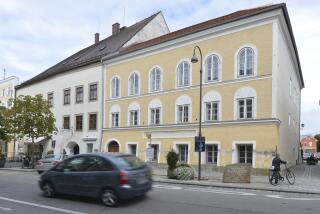Christo Puts the Reichstag Under Wraps : Art: Many German politicians--including Chancellor Helmut Kohl--fought to keep the historic building uncovered. Its notorious past is what attracted the artist.
- Share via
BERLIN — The last piece of shiny silver fabric slid into position Friday, the last thick blue ropes were being knotted, and wrap-meister Christo was finally able to step back and admire his achievement: After 24 years of preliminaries, he had wrapped the Reichstag.
Consensus among the many spectators who have been congregating on the building’s sprawling lawns for the past six days was clear: Germany’s once-and-future Parliament looks much better wrapped than unwrapped.
“I’m familiar with the Reichstag without the material, and it looks like a big mountain,” said Susanne Wilhelm, a receptionist who had taken the train from Cologne, on the other side of Germany, to watch the Bulgarian-born conceptual artist at work.
“Now it looks very light,” she added approvingly, gazing up at Christo’s huge masterpiece, broad as 1 1/2 football fields, its loosely pleated folds shimmering softly under the afternoon’s cloudy skies.
Wilhelm, a fan of Christo’s ever since she stumbled upon his wrapped Pont Neuf bridge while on vacation in Paris in 1985, said she was fantasizing about how nice it would be if, when Christo removes the silvery wrappings as scheduled in two weeks, the building underneath had disappeared.
It’s hard to find a German who really likes the Reichstag, an imposing edifice in the Wilhelmine style, which was torched--presumably by the Nazis--in 1933, shattered by the Soviets in 1945 and left stranded in the middle of nowhere when the East German government built the Berlin Wall and adjacent “death strip” down its eastern facade.
It was this legacy that motivated Christo to swathe the Reichstag in fabric, as he has done over the years to trees, statues, a woman, an art museum, the Pont Neuf and part of the Australian coastline, not to mention his 1991 project: re-landscaping stretches of land near Los Angeles and Tokyo with giant blue and gold umbrellas. And it was the Reichstag’s turbulent history that prompted many leading German politicians--including Chancellor Helmut Kohl--to fight its wrapping.
Some of Christo’s critics think his work trivializes the Reichstag, others fret about the cost.
*
“In my neighborhood, a lot of people are criticizing it,” said Tim Settgast, a hobby photographer taking pictures of the building. “They haven’t read the newspapers and they don’t know it’s not being paid for by the taxpayers.”
In fact, Christo and his wife, Jeanne-Claude, make a practice of refusing all corporate commissions or government grants for their projects. They financed the $10-million Reichstag-wrapping by turning out thousands of drawings of their concept and selling them.
What the drawings couldn’t capture was the way the shiny fabric now moves with the wind and ever-so-subtly changes color as the clouds pass before the sun. Thousands of sightseers have been sitting on the Reichstag lawn all week, staring at these monotonous but oddly hypnotic sights.
“There must be 50,000 people here every day,” beamed Frank Krueger, a street-market vendor who had closed down his stall for the week and sneaked onto the grounds with an illicit portable grill, bratwursts and a dolly stacked with cases of Coke and beer.
“Normally, it’s forbidden to sell anything here because Christo is an artist, and art and business don’t mix,” he said. “But you can see that there are a lot of people here, and they need something to drink.
“I hope he’ll make more of these,” Krueger added, smiling up at the Reichstag. “Some people are saying, ‘So many millions of marks, for this!’ But I think it’s super. The building looks smaller, less aggressive. It looks like a toy.”
More to Read
The biggest entertainment stories
Get our big stories about Hollywood, film, television, music, arts, culture and more right in your inbox as soon as they publish.
You may occasionally receive promotional content from the Los Angeles Times.










